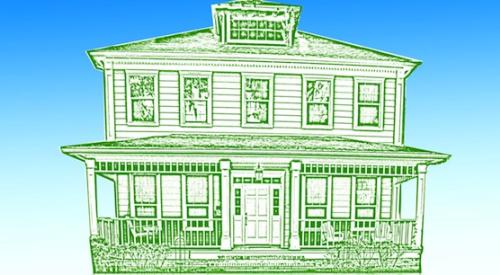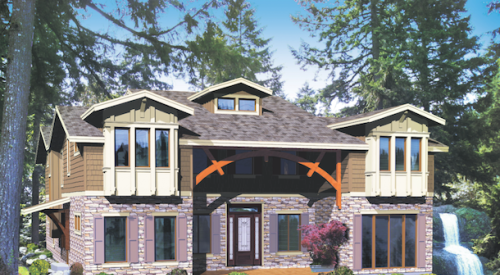|
No one would argue green isn't good, and there's concrete evidence that home builders are taking it seriously. About two-thirds of respondents to a June 2007 Professional Builder survey strongly or somewhat disagreed with the statement that green building is a fad. Last year, in a McGraw-Hill Construction survey, NAHB builder members predicted that 40 to 50 percent of new homes built in 2010 would be green. That might be a stretch, but it shows how much green building has affected the housing industry.
Builders are also sampling a variety of green certification programs. According to the PB survey, 62 percent had used Energy Star, 32 percent had used the NAHB program and 19 percent had used LEED. However, 37 percent picked the "other" category, suggesting they've used a variation on one of the brand-name national programs. Not included in the survey were local or regional programs — about 85 of them. Variety is clearly the name of the green-building game. To some that's a detriment, but others see it as an advantage.
NAHB reports that as of June 2007, 1,564 builders were involved in voluntary, HBA-driven green-building programs around the country. Of that number, 225 are involved in programs based on the NAHB Model Green Home Building Guidelines. Still in the pilot phase, the U.S. Green Building Council's (USGBC) LEED for Homes program is expected to roll out nationally by November 2007. At press time, 375 builders were registered in the LEED-H program.
In many respects, the NAHB and USGBC programs are similar. "The categories into which they're divided are typical of green building templates that are in place around the country, though there are more prerequisites involved in the LEED rating system," says Ron Jones, owner of Sierra Custom Builders in Placitas, N.M., who served on both the LEED for Homes committee and the NAHB green building subcommittee.
"We feel very strongly that there's a huge opportunity for us to work together for the common cause," says Jay Hall, acting director of LEED-H. Yet the NAHB and the USGBC can't seem to play nice, though Hall bristles at talk of any friction between the two organizations.
But Emily English, director of the NAHB green building program, told Professional Builder, "The tension between our organizations stems from the fact that we've seen evidence that USGBC is trying to put their programs in front of legislators and get them mandated, and we don't want green building mandated. We especially don't want pieces of legislation to reference one program, because that really freezes innovation in place."
True to their word, the NAHB hasn't pushed for a mandate, though in cooperation with the International Code Council it developed a national green-building program based on the guidelines. The program was approved by the NAHB Board of Directors in June 2007 and will be released in early 2008. Its purpose, according to the organization, is "to provide a template for voluntary, market-driven green building."
Jones says although USGBC, on the official level, professes LEED-H should be a voluntary program, local USGBC chapters are trying to get ordinances enacted that would require homes to be built to the LEED standard. "So [NAHB] pushes back against that because they don't want to have somebody else's version of green mandated as the only choice."
Green and GreenerSteven Winter, FAIA, principal of Steven Winter Associates in Norwalk, Conn., is an architect and building-systems consultant whose firm certifies LEED buildings and writes standards for local green certification programs. Winter's staff has been working with the NAHB standard as well and did several analyses where production homes were run through both programs. A home becomes greener as it moves up through the three tiers of the NAHB program (bronze, silver and gold), he says.
NAHB's guidelines are divided into seven "guiding principles" or sections: lot design; preparation and development; resource efficiency; energy efficiency; water efficiency; indoor environmental quality; operation, maintenance and homeowner education; and global impact. At all tiers, a minimum number of points are required for each of the seven guiding principles.
The LEED-H rating system has four levels or, as USGBC calls them, shades of green: certified, silver, gold and platinum. Points are awarded in each of eight categories: innovation and design process; location and linkage; sustainable sites; water efficiency; energy and atmosphere; materials and resources; indoor environmental quality; and awareness and education. Some categories have prerequisites. For instance, third-party testing must verify that the project meets Energy Star for Homes criteria. Projects must earn a minimum amount of points to achieve each level.
The NAHB has admitted that its guidelines are best suited to builders who haven't yet looked into Energy Star. Winter says LEED-H picks up where NAHB gold leaves off. LEED-H, which is positioned to recognize and reward the top 25 percent of builders in the country in terms of environmental stewardship, targets builders who wish to go beyond Energy Star.
"It's interesting what's taking place at the political ends of the landscape," says Winter. "All the local programs were moving along nicely and doing what appeared to be 15,000 to 20,000 homes a year in the aggregate. But when LEED for Homes was developed, some local [HBAs] were concerned that they'd be competing for the same funding sources, although the USGBC has had discussions with many of them about doing a kind of co-branding initiative."
Generally speaking, LEED-H is more stringent. "Some builders who have been at the forefront of green, like McStain [Neighborhoods], might prefer LEED because it sets them apart from their competition," Winter says. "At the same time, the NAHB standard is good because it makes it easier for a builder to get onto the first rung of the green ladder. So I personally think the two standards should be working side by side."
Hall points out that LEED-H requires third-party verification and performance testing while the NAHB program does not. "Many [green certification] programs don't require this," he says. "It's basically the builder voluntarily participating and saying what he actually accomplished."
Builders must achieve a certain number of points in each section of the NAHB guidelines, but how they get there is up to them, says English. "They get to pick and choose from the line items whatever makes the most sense in their region and what's most cost-effective," she says. "LEED for Homes has a lot of mandatory measures that [builders] have to do no matter what part of the country they're in."
Hall maintains that the LEED-H checklist is simple and builder-friendly compared to other programs. "If you look at the NAHB guidelines, I'll say loosely that about a third of the measures in that rating system are related to building materials. That's wonderful, but it doesn't send a clear message in terms of what the builder should be focusing on. In LEED-H, we've broken it up into five [categories] and require that something be done in each of the five."
Within each category, LEED-H recommends a variety of strategies the builder can pursue. Each strategy is labeled good, better or best so that builders who are less familiar with green can focus on the "good" practices, while those who want to be more aggressive can go after the "better" or "best" practices.
"The perception that LEED-H has a higher level of difficulty is totally wrong," Hall says. "That [perception] relates to the commercial building program. When we designed LEED-H, we developed a documentation approach that's extremely streamlined; basically there are three forms that have to be completed and submitted."
Another difference is cost. Documentation and verification fees are established by LEED for Homes providers: local organizations with demonstrated experience and expertise in their markets. Currently, 12 LEED-H providers are contracted through the USGBC to provide services to builders. They're located in Arizona, California, Florida, Georgia, Michigan, New Jersey, Oklahoma, Oregon, Pennsylvania, Texas, the Northeast and Canada. Fees for the initial verification tasks range from $500 to $3,000 per home and depend on home size, LEED performance tier, travel time the rater requires, the number of homes being built and the builder's experience with green-building techniques.
"Our guidelines are being used by HBA programs that are doing certification locally at a much, much lower cost — something like $250," says English. Calli Schmidt, NAHB's director of environmental communications, adds that many home buyers would rather upgrade to a higher-efficiency air conditioner, extra insulation or some other "green" feature than pay a few thousand extra for the LEED-H label.
Matt Belcher, president of Belcher Homes in Kirkwood, Mo., has built houses that comply with both programs. Belcher doesn't think one makes a house greener than another, but he believes LEED-H scrutinizes the lot more closely, especially when it's an infill project.
From a builder's standpoint, Belcher says the NAHB guidelines work well "because there are different ways to get to the same thing, and you need that flexibility on a construction site because things just happen."
Green? Says Who?In the PB survey, 87 percent of respondents said there should be minimum standards of performance and sustainability before a builder can market a home as green. As for who should set the standards, 32 percent of respondents said an independent, third-party program; 24 percent, a trade association; 15 percent, federal government; 15 percent, state government; and 8 percent, local government.
Those opinions reflect the fragmented approach to certifying green homes today. Many local and regional green-building programs have similar rating systems and standards. It may make sense to consolidate them into a single, national green-building program.
The proliferation of programs is one reason green home building hasn't really taken off nationwide, says Winter. "Production builders that work in 30 or 40 states can't be complying with 30 or 40 different standards," he says. "Insurers, appraisers, lenders ... none of them will get behind something that varies from city to city and state to state. What I think is going to happen long-term is that the local programs will continue to manage their implementation but may look to one of the national [programs] for the standard they adopt, just as building codes develop nationally but are implemented locally."
Still, allowing the federal government (or some other entity) to dictate green-building standards is another matter. Belcher fears that a green-building mandate would create an economic hardship for an industry that's already in a slump, and wouldn't allow for the efficient adoption of new technology.
Do consumers really care which green program their builder uses? At the moment, no, say most of the sources consulted for this article. Belcher believes as time goes on, consumers will demand that builders be held accountable to certain standards.
"Frankly, as green building moves away from being a kind of passion-driven thing into a more practical reality, there are issues that are going to have to be addressed," he says.
Winter emphasizes that there is nothing inherently wrong with the competition between NAHB and USGBC.
He just thinks the two organizations should compete in a more civilized way."
| NAHB | LEED-H |
| A minimum number of points must be earned in each of seven "guiding principles" (sections) in order for the project to be rated bronze, silver or gold. | A minimum number of points must be earned in each of eight categories in order for the project to be rated certified, silver, gold or platinum. |
| There are some prerequisites; for example, to receive points for passive solar design, builders must use sun-tempered design methods. | There are prerequisites in a number of categories, including Energy Star certification. |
| Fees are approximately $250 per home. Line items can be verified in several ways, including builder spec sheets and installer certification. | Fees range from $300 to $5,000 for documentation and verification. |
| Third-party verification and testing is required in all cases. |
|












